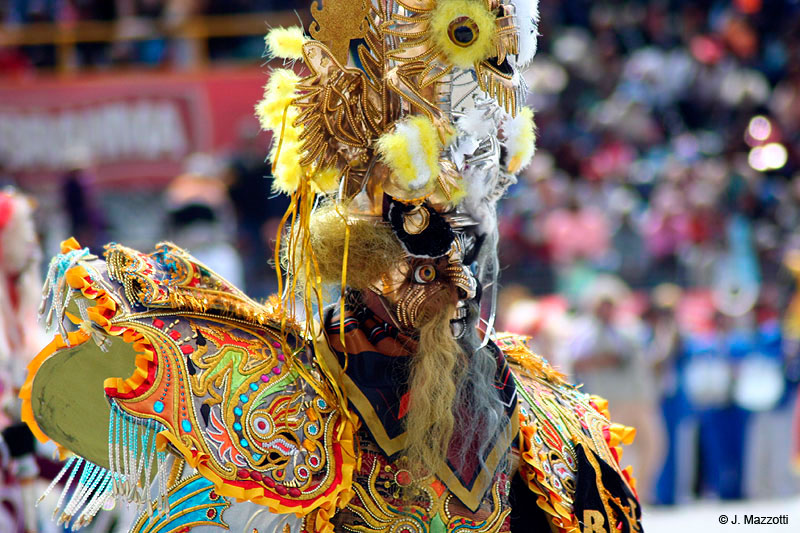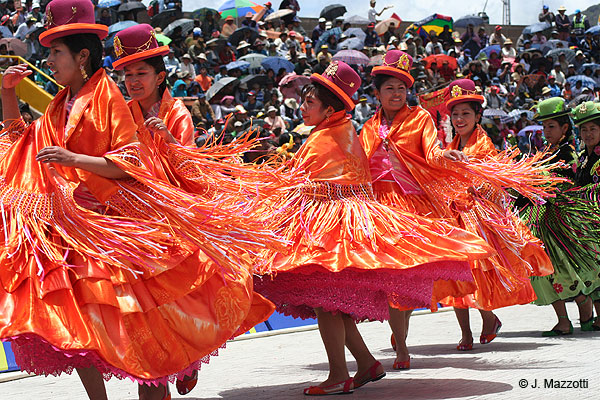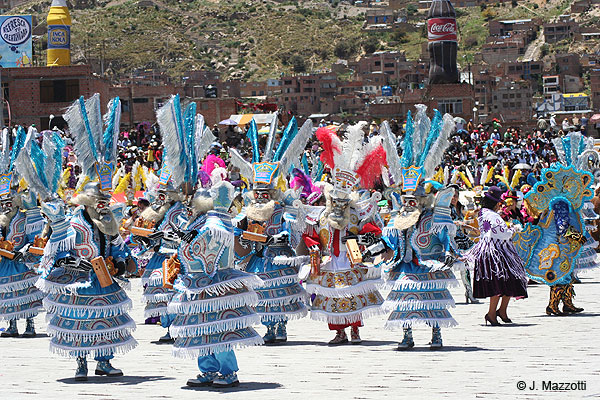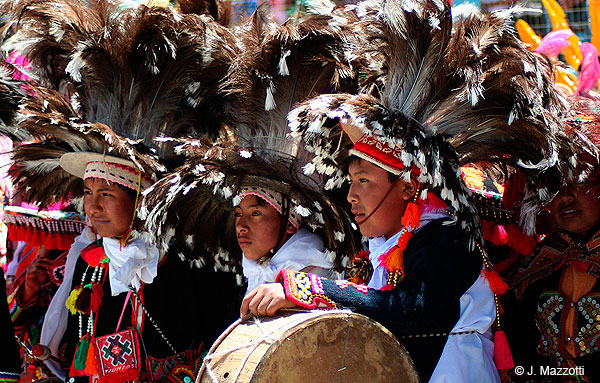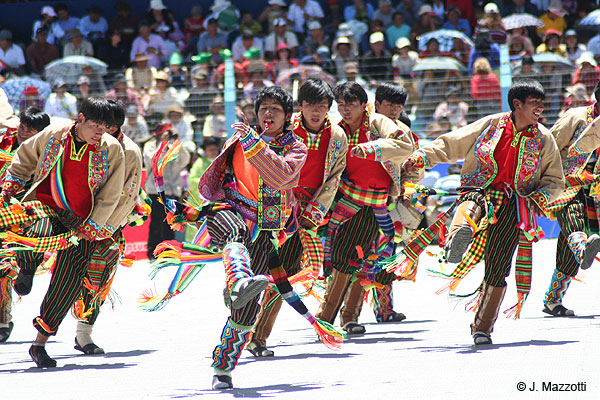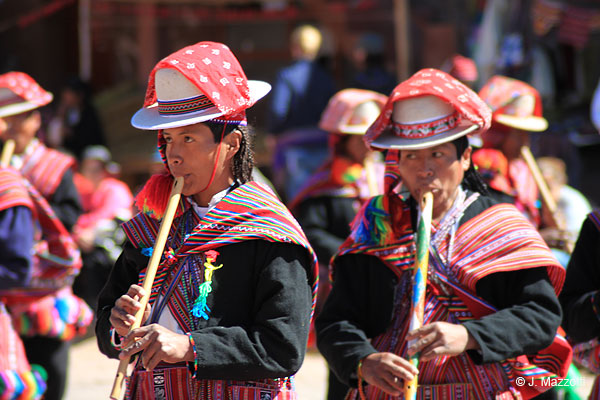Art, Folklore and Feasts in Puno

Festivals and legends on the edge of Titicaca
Puno offers excellent opportunity to found a Living Culture, prepare to surrender to its magic. The celebration of almost hundred popular feasts per year is but one small hint of the vast treasure trove of multicultural traditions you will find here.
Puno's natives live the same way as their ancestors did a thousand years ago; maintaining their dances, handcrafts, textiles, customs and keeping their spirit alive.
In this region the folklore is manifested in two big ways, one in the customs and ancestral rites in the forms of life of some towns, among those highlight the communities of the Uros, Taquile and Amantaní, and the other one in its artistic manifestations.
Expert artisans and indigenous weavers elaborate art objects of captivating beauty by hand. The art of weaving alpaca and sheeps wool has been kept alive by the people of the highland plains. They also make musical instruments such as the siku and zampoñas (pan pipes). The best-known crafts include Toritos de Pucará (Pucará bulls) and the Ekeko, a character who carries a variety of objects and products for good luck.
On 2005 Taquile Island was proclaimed by UNESCO as "Intangible Cultural Heritage of Humanity" by its textile art, which is produced as an everyday activity by both men and women, regardless of their age, and worn by all community members.
Masks
Many Andean dances use masks as part of the dancer’s costume. The most common motifs include demons, angels, blacks (negritos), Spaniards (españoles) and all kinds of animals. The most important exhibition of masks is held in the southern Andes, such as during the festival of the Virgen de la Candelaria.
The Quena
Peru’s most widely-played wind instrument, the quena dates back to the pre-Hispanic era. Made from a hollow tube of cane, wood, bone or plastic, the quena features a chiseled mouthpiece. The instrument is pierced with five or six soundholes which produce the notes depending on the combination of fingers and how the musician blows into the instrument. Each region has come up with its own size quena.
The Zampoña
A member of the pan-pipe family, this instrument is made of a cluster of different sized cane tubes bound together, forming one or two rows. The size of the tube determines the musical note it emits. The instrument comes in different regional variations, featuring canes of different size, number and shape. The zampoña is commonly played in festivities in southern Peru, especially in the department of Puno. One of the variations is the antara, which is crafted from the finest cane available.
Dances of Puno
Puno city has been denominated the "folkloric capital of Peru" by the wealth of its artistic and cultural expressions, especially through the dance and music. There are registered more than 300 autochthonous and religious dances, from the 1,500 existing in Peru.
These dances reach their biggest manifestation in the celebration, in February, of the Feast of the Virgen de la Candelaria (considered as one of the most important from Peru) and in the Regional Competition of Autochthonous Dances, being their people's maximum expression. Among the main rural dances we can mention the Waca Waca, the Cullahulla (it represents the actions of a quack doctor), the Carnival of the Ichu, the Kajelo (it represents a horseman that dominates the summits and abysses, with Andean suit), the Llamerada (danced with great order and uniformity to the tune of a wind instruments band), the Wifala (pastoral loving and deliberate dance), the Sikuris (similar to the Diablada), the Machu Tusuj (of satirical character that exalts the fecundity, vigor, dexterity and eroticism of the old people), etc.
Among the dances of the city we can mention the Diablada, the Marinera Puneña, the Pandilla, the Morenada, Rey Moreno, the Caporales, etc. In both dance types out stands the fantasy clothes and suits of their dancers, many are made with threads of gold, semi-precious stones and embroideries and exquisite laces, with a high value.
Diablada
The Dance of the Devils, or "diablada", the main dance of the festival, was allegedly dreamed up by a group of miners trapped down a mine who, in their desperation, resigned their souls to the Virgen de la Candelaria. The "diablada" dance is born with the legend of some miners trapped in a collapse of a mine; they saw an army of demons that took them to hell illuminated with fire flames. The miners commended to the Virgin who kept them with life producing their rescue. From that time all the miners called her their landlady and protector, and she was called the Virgin of the Candela or Candelaria. The "diablada" is the dramatization of this legend, the fight among the good and bad, which is presided by an archangel that dominates the demons that are accompanied by the "chinasupay" (the devil's woman), in the processions of the feast. The fantasy clothes worn during this dramatization are a masterpiece.
Sikuri
This is the somewhat martial dance of the Sikuris, a people who originated in the Andean tundra region called the Altiplano. It is danced in several groups forming troupes or comparsas which are organized in large circles around musicians playing zampoñas of varying sizes. The choreography displays the complementary and harmonic nature that should be present in all human integration, as one group can only play half the notes, making the other group indispensable for the full melody.
Coca leaf and offering to the Earth Goddes
The mystique of fertility - Pre-Columbian religions have lived on as part of ancestral rites that link Man with Nature, particularly in the Andean world, rites that take on major symbolic importance. The Pachamama or Mother Earth, goddess of fertility, lives in Urkhupacha, or the inner world, whose fruits she offers up to feed mankind. This is why, within the reciprocal logic of the Andes, during August the villagers make offerings (known as pagos or pagapus). The offering consists of coca leaves, unworked silver, chicha, wine and jungle seeds attributed with symbolic and magic powers called huayruros. The same offering is made to the Apus, the spirits of their ancestors who are said to live within the mountains. Coca, a sacred plant which served to mediate between the inner world (the Apus and the Pachamama) and the exterior world (Man) can be found in countless mestizo religious ceremonies in communities in the provinces and even in the cities. The leaves, when chewed and mixed with saliva to form a wad in the mouth (a process called chakchar), help the user forget his weariness while working. Spread over a blanket on the ground, coca leaves are also read to predict the future.
Festivities in Puno
Most of them are dedicated to a patron saint, falling within the Christian calendar imposed during the Vice-regency, after having been carefully adapted to the magical and religious beliefs of a particular region.
These big celebrations have the participation of the whole people of Puno and also communities of near towns.
Festivity of Virgen de la Candelaria
February 2 (central day)
The Festivity of Virgen de la Candelaria, celebrated each February in the city of Puno, includes activities of religious, festive and cultural character that draw on Catholic traditions and symbolic elements of the Andean worldview. The main festival commences at the beginning of the month with a daybreak mass, followed by an ancient purification ceremony. A liturgical act the next morning leads into a religious procession, as the image of the Virgin is carried aloft along the streets accompanied by traditional music and dancing. The festival continues with two contests that attract numerous groups gathering several thousand dancers and musicians from across the region. The main practitioners are rural and urban inhabitants of the Puno region who belong to the Quechua and Aymara ethnic groups. Many emigrants from Puno also return to participate, reinforcing a sense of cultural continuity. Three regional federations of practitioners cooperate to organize the festivity and preserve the traditional knowledge and skills associated with dance, music and mask-making. Rehearsals and crafts workshops are the places where these skills are passed on to younger generations. The festivity closes with a ceremony for the Virgin, a parade and farewell masses. Intangible Cultural Heritage of Humanity.
Carnivals
February - March (Movable)
Peruvian carnivals are marked by the festive character of Andean areas, which regularly break with their solemn traditions Peruvians across the country are extremely fond of tossing buckets of water at each other during this festival, so onlookers would be wise to take precautions. Cities where carnivals reach a high point include Cajamarca and Puno. The celebration date is movable, generally during the first fifteen days of February. The celebrations last almost a month, since the preparation activities; the central days are just one week from Wednesday to Wednesday. The citizens organize in commissions by districts.
Easter Week
March - April (Movable)
Easter week represents the peak of religious sentiment for the people of the Andes. The week starts out with the entry of Jesus into the city riding on a donkey. On Wednesday, the images of the Virgin Mary and Saint John are paraded in fervent processions through streets carpeted with flower petals until they meet up with the litter bearing the image of Christ, whom they"greet" in the main square. On the evening of Holy Friday, the lights of the city wink out to give way to the Christ of Calvary. The image sets out from the church in a procession through the streets on a litter strewn with white roses, followed by the grieving Virgin Mary and lines of men and women strictly dressed in mourning bearing lit candles. The litter, which features thousands of white candles, is simply magnificent. The litter is then accompanied with prayers and songs throughout the night until the three-hour sermon is delivered on Saturday. After days of grieving, Resurrection Sunday takes on a festive air, Christ is resurrected and appears once more on his litter and is carried through the streets.
Alacitas Fair (Thumbnails)
May 1
This is a festival featuring the sale of miniatures, in the form of figures and household objects. In the Aymara language, Alacitas means "buy" and that is precisely what is done in this fair, where the character is the most sought Ekeko, a fat man, considered as a sort of god of fortune, who "charge" the dreams of people who buy it. The "yatiris" specialists in ritual and medicine, bless property acquired during the fair.
Feast of the Santa Cruz (Saint Cross)
May 3
This festival, which is widespread in the highlands, is organized by the members of each community who decorate their respective crosses and prepare then for the procession to neighboring churches.
Feast of Santiago Apóstol
July 25
(Pomata, Lampa, Taquile and Amantaní) The natives identified the Christian apostle Santiago, with Illapa, the Inca god that represented the ray. Masses and processions, and dance to the music of the sikus (type of flute square resembling the bagpipe) and zampoñas. There are also bullfights fun.
All Saints Day and Day of the Dead
November 1 and 2
Speaking to the souls of the departed On these days, which are dedicated to the memory of the dead, Peruvians tend to attend Mass and then in coastal communities, head to the cemetery, bringing flowers and in the highlands, food to share symbolically with the souls of the dead. The worship of the dead was a common and respected custom during pre-Hispanic times in Peru, and part of that tradition, combined with Christian elements, still lives on today.
Anniversary of the founding of the city of Puno
November 4
Civic events and dancing in the streets of the city by school students, as well as the staging of the legend of the founders of Cusco and the Inca dynasty, Manco Capac and Mama Ocllo.






